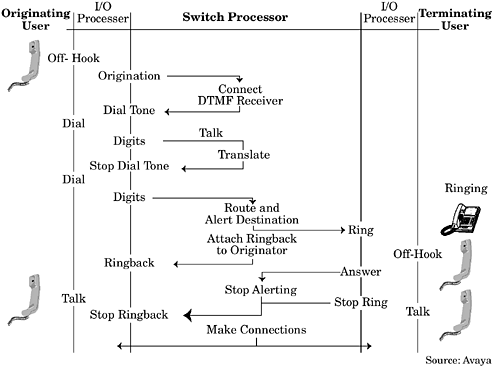The primary call processing responsibilities of the Main System Processor are provisioning of dial tone, digit reception and analysis, number analysis, TDM bus talk slot assignments and switch connections for intercom and trunk calls, routing analysis, feature provisioning, and call monitoring.
There are several fundamental main processor management functions used to process calls:
-
Call sequencing control: management of the call sequence logic that takes a call from one state to another
-
Resource management: management of various system resources, such as DTMF receivers; time/talk slots for call connections; tone generators; and internal software records for call processing (including the system dial plan), messaging, measurements, and call detail records
-
Terminal handling: management of different desktop terminal models, including support of line appearances, feature buttons, display fields, adapter modules, and other functional components
-
Routing and termination selection: controls the selection of the terminating endpoint (station, trunk) of the call, including functions such as hunting, bridging, call coverage, and least cost routing.
Call processing is a series of events that result in the completion of a call. Figure 1 illustrates the call dialing and connection process. The process begins when a port (station or trunk) changes from an idle to an active state. Port seizure occurs when a station goes off-hook, a trunk port circuit receives an incoming call signal from the Central Office or network, or an attendant begins dialing. When a station port has been seized, the main processor seizes a register storage record, instructs a tone sender unit to send dial tone to the caller, and instructs the switch network to establish a connection to the port. When a CO or DID trunk port has been seized, the main processor seizes a register storage record, assigns a tone receiver unit register to the port, and instructs the trunk circuit port to signal that the main processor is ready to receive digits.
The second step in the call process is digit reception and analysis. Digits are sent by system users to dial another station or activate a specific feature. A call register stores dialed digits or received digits over a trunk circuit. Digits can be received one by one (manual dialing) or in a group if a dialed number has been preprogrammed—speed dial. For station initiated calls, the first digit received by the register suppresses the dial tone. There is typically a time-out period between going off-hook and dialing the first digit or between the first and second dialed digits; if no digits are dialed within the programmed period, an intercept tone is sent to the caller. In addition to seizing a register, a tone sender and receiver are simultaneously seized, a switch connection is made, and the Class of Service of the caller is checked. A no-progress tone is sent to the caller if a tone receiver cannot be seized.
The third step in the call process is number analysis. Number analysis allows the PBX system to identify the number dialed and properly route the call. Internal system number analysis is performed for all calls, both intercom and trunk calls, within the PBX system. Special number analysis processes are performed for DID trunk calls and dialed feature access codes using * and # keys. For incoming DID trunk calls, the main processor analyzes the digits to determine whether the number is an attendant console position. If the number is an attendant console position, the call is processed and routed to the attendant. If the number is not an attendant console position, the internal number analysis program analyzes digits.
The internal number analysis program determines the correct call processing procedure to be implemented. There are many types of dialed or received numbers that can be analyzed for call routing purposes: station number, including hunt group number; individual, group, or emergency attendant number; abbreviated dialing number (speed dial); paging number; automatic route selection access code; Direct Inward System Access (DISA) code; data station number; modem pool group access code; and external destination codes, such as 911. If a number is not defined in the number analysis program, it is treated as a vacant number, and the appropriate intercept treatment is applied.
Another important main processor function is provisioning of call progress tones and indications. Call progress tones and indications are single- and dual-frequency combinations applied in a variety of cadence patterns, such as continuous tone sending, one repeated sequences (tone, pause, tone pause…), two repeated sequence (tone 1, pause 1, tone 2, pause 2…), or three repeated sequences (tone 1, pause 1, tone 2, pause 2, tone 3, pause 3…).
Call progress tone types include:
-
Busy tone
-
Call diversion indication (call forward indication)
-
Call waiting indication
-
Conference tone
-
Confirmation tone
-
Dial tone
-
Expensive route warning tone
-
Intercept tone
-
Intrusion tone
-
Message waiting tone
-
No-progress tone (congestion tone)
-
Off-hook queue tone
-
Recall dial tone
-
Ringback tone
-
Special dial tone (do not disturb tone)
-
Special message waiting tone (message waiting)


No comments:
Post a Comment